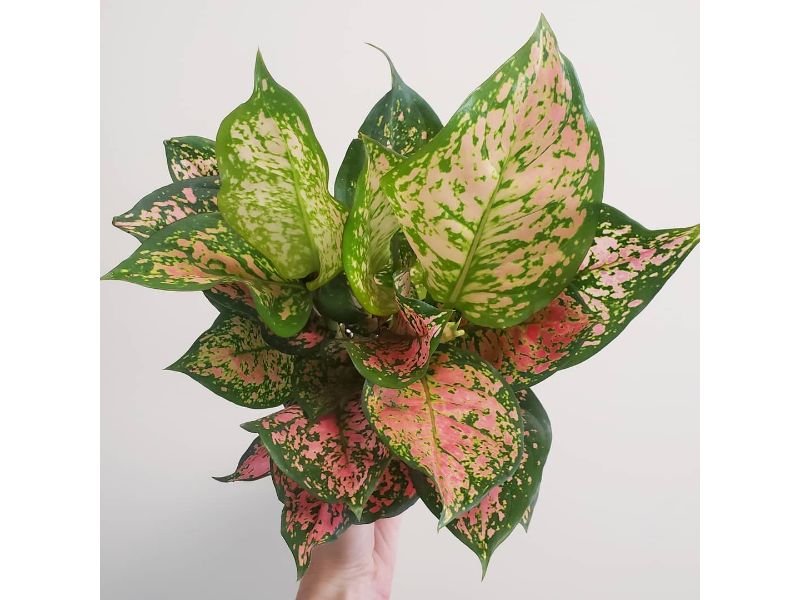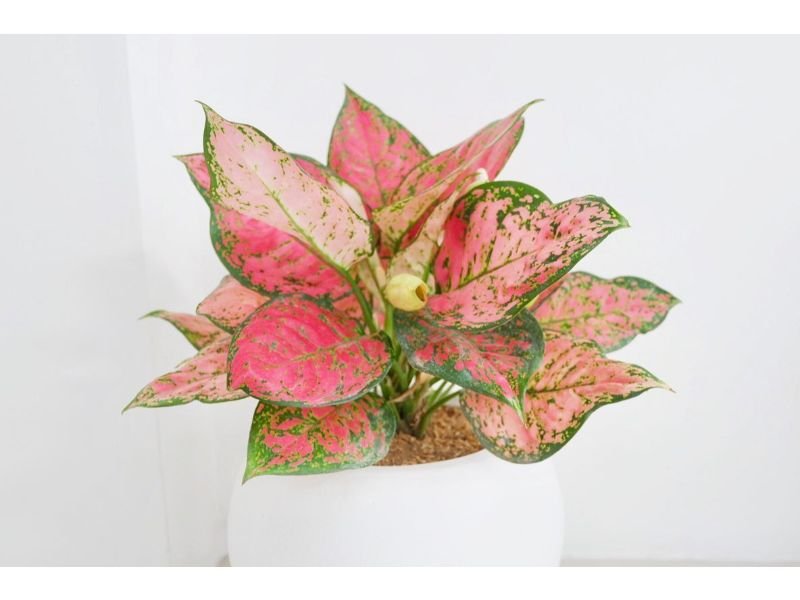Table of Contents
Brief Overview of Aglaonema Pink Lady
Aglaonema Pink Lady is an evergreen plant variety that belongs to the family Araceae. It is native to Southeast Asia, where it grows in tropical forests in low-light conditions. The plant has distinctive oval-shaped leaves that are dark green with pink tones on the edges or tips.

Aglaonema Pink Lady is a popular houseplant choice due to its striking appearance and low maintenance requirements. The plant can grow up to three feet tall when matured and thrives in filtered light environments with minimal water requirements.

In this article, we will discuss in detail what Aglaonema Pink Lady is and how you can care for them effectively. Whether you’re a seasoned gardener or new to indoor planting, there’s something here that will benefit you regardless of your experience level.
What is Aglaonema Pink Lady?
Description of the plant’s appearance and characteristics
Aglaonema pink lady, also known as Chinese Evergreen, is a popular indoor plant known for its beautiful foliage. The leaves are large, glossy, and oval-shaped with pointed tips. The colors of the leaves are usually a mix of different shades of green with pink highlighting the veins.
The colors can vary depending on the lighting conditions. The plant has an upright growth habit and can grow up to 24 inches in height.
Some Aglaonema pink lady varieties have variegated leaves with cream or white markings in addition to green and pink. This striking display of color makes it a popular choice for home décor enthusiasts who want to add a touch of nature to their living spaces.
Origin and History of the Plant
Aglaonema pink lady is native to Southeast Asia, particularly China and the Philippines. It belongs to the Araceae family which includes plants such as peace lilies and caladiums. The plant was first introduced into Europe in 1885 by Gustav Wallis; he discovered it while exploring various regions in Southeast Asia.
Since then, Aglaonema pink lady has gained worldwide popularity due to its low maintenance requirements, making it ideal for indoor gardeners who want beautiful plants without having to put too much effort into their care. Moreover, this species has been extensively cultivated; there are now over 20 different cultivars available at nurseries that vary in size, pattern, coloration, and shape from what you may see growing in nature!
Benefits of owning an Aglaonema Pink Lady

Air Purification Properties
Aglaonema Pink Lady is known for its powerful air purification properties. Indoor plants can help remove pollutants from the air by absorbing them through their leaves and roots. According to a study conducted by NASA, Aglaonema Pink Lady is one of the most effective plants at removing toxic substances such as formaldehyde, benzene, and trichloroethylene from indoor air.
These harmful chemicals are commonly found in everyday household items such as furniture, cleaning products, and textiles. By placing an Aglaonema Pink Lady plant in your home or office space, you can significantly improve the quality of indoor air and reduce the risk of health problems associated with exposure to toxins.
Aesthetic Appeal
In addition to their air purification properties, Aglaonema Pink Lady plants are also highly prized for their aesthetic appeal. With its striking green leaves adorned with splashes of pink coloration, this plant adds a touch of natural beauty to any indoor setting.
Aglaonema Pink Lady plants come in various sizes with different shapes and patterns on their leaves making it easy for you to choose one that matches your home’s decor. Furthermore, they require minimal effort to care for compared to other houseplants because they remain attractive even when placed in low-light areas.
Low Maintenance Requirements
One of the main benefits of owning an Aglaonema Pink Lady plant is that it requires minimal maintenance compared to other houseplants. These plants are known for being relatively low maintenance due to their ability to tolerate varying levels of light and humidity. They do not require frequent watering as they have thick stems that store water which helps them survive even if left unattended for a few days.
Additionally, they do not need regular fertilization as they can survive on the nutrients in the soil for extended periods. This makes Aglaonema Pink Lady plants an excellent choice for those who want to enjoy the benefits of indoor gardening without dedicating a lot of time and effort to maintaining their plants.
How to Care for Aglaonema Pink Lady

Lighting Requirements
Aglaonema Pink Lady requires bright, indirect sunlight to thrive. It is important to place the plant in a location with enough light but not in direct sunlight, as this can damage the leaves. The plant prefers partial shade and can even grow in low light conditions, but it will not produce new growth or variegation as quickly.
To avoid underexposure, it is recommended that you rotate the plant every few weeks to ensure that all sides receive equal amounts of light. Overexposure to sunlight can also cause damage to the plant’s foliage.
If you notice that the leaves are turning yellow or brown, this may be an indication of too much direct sunlight. In this case, reduce the amount of light by moving the plant further away from any windows or providing some shade through curtains or a sheer cloth.
Watering Requirements
Aglaonema Pink Lady prefers slightly moist soil and should be watered when the top 1-2 inches of soil feels dry to the touch. Overwatering can cause root rot and other issues, so it’s important not to let the soil stay too wet for too long. It is recommended that you use room-temperature water and allow it to drain properly before placing it back in its spot.
Signs of overwatering include yellowing leaves with brown tips or a foul odor emanating from your potting mix which indicates fungal growth due to excessive moisture. Underwatered plants will have dry and crispy leaves and wilting foliage.
Soil and Fertilizer Needs
Aglaonema Pink Lady requires well-draining soil with good organic matter content such as peat moss mixed into potting soil. Fertilization should occur once a month during warm months from March through August using a balanced water-soluble fertilizer. You can reduce the frequency of fertilization during winter months.
Temperature and Humidity Needs
Aglaonema Pink Lady prefers temperatures between 60°F to 85°F and should be kept away from cold drafts near doors or windows. Additionally, the plant needs high humidity levels to thrive. If you live in a dry climate, adding a humidifier or grouping plants together can help increase moisture levels around your Aglaonema.
Pruning and Propagation Techniques
To promote healthy growth, prune any yellow or brown leaves as they appear. This will help prevent diseases from spreading and keep your plant looking fresh. Also, deadheading regularly by removing spent flowers helps promote new growth.
Propagation can be done through stem cuttings (about 4-6 inches in length) taken from parent plants with multiple leaves or offshoots that have already rooted in the soil nearby the parent plant. Cuttings should be placed in warm, moist soil until roots grow then transferred to their own pot with well-draining soil when ready for transplanting after a year of growth.
Top 10 Essential Gardening Tools Every Plant Lover Should Have
Common Problems with Aglaonema Pink Lady
Identification of common pests and diseases
Aglaonema Pink Lady is a relatively hardy plant that is resistant to most pests and diseases. However, like all plants, it can still be affected by certain issues from time to time.
One of the most common problems faced by Aglaonema Pink Lady owners is spider mites. These tiny insects typically thrive in dry and dusty environments, so maintaining proper humidity levels around your plant can help prevent infestations.
If you do notice spider mites on your plant, you can gently wash them away with a stream of water or use neem oil to treat the infestation. Another pest that can be problematic for Aglaonema Pink Lady is mealybugs, which are small white insects that feed on the sap within the plant’s leaves.
These bugs leave behind a sticky residue that attracts ants and other insects, so they should be dealt with as soon as possible. You can wipe away mealybugs manually or use an insecticidal soap to get rid of them.
In terms of diseases, root rot is one of the biggest concerns for Aglaonema Pink Lady owners. This condition occurs when the roots become waterlogged and begin to decay, often due to overwatering or poor drainage.
Signs of root rot include yellowing leaves and wilting stems. To prevent this issue from occurring, make sure you’re using well-draining soil and allowing it to dry out slightly between watering sessions.
Tips for preventing common problems
While there are a few pests and diseases that can affect Aglaonema Pink Lady, there are several steps you can take to prevent these issues from arising in the first place: – Keep your plant clean: Regularly dusting off your Aglaonema Pink Lady’s leaves will help prevent the buildup of dust and debris that can attract pests.
– Maintain proper humidity: As mentioned earlier, spider mites tend to thrive in dry environments, so it’s important to keep the air around your plant moist. You can use a humidifier or simply mist your plant with water once a week.
– Don’t overwater: Overwatering is one of the biggest causes of root rot, so make sure you’re allowing the soil to dry out slightly between watering sessions. You can also improve drainage by adding perlite or sand to your soil mix.
– Check for pests regularly: Keep an eye out for any signs of infestation, such as webbing or sticky residue on leaves. Catching these issues early will make them easier to treat and prevent from spreading.

Gardening is my passion and growing plants indoors has always been a stress relief for me. Grow a banana tree in my apartment once (although failed to produce bananas).






